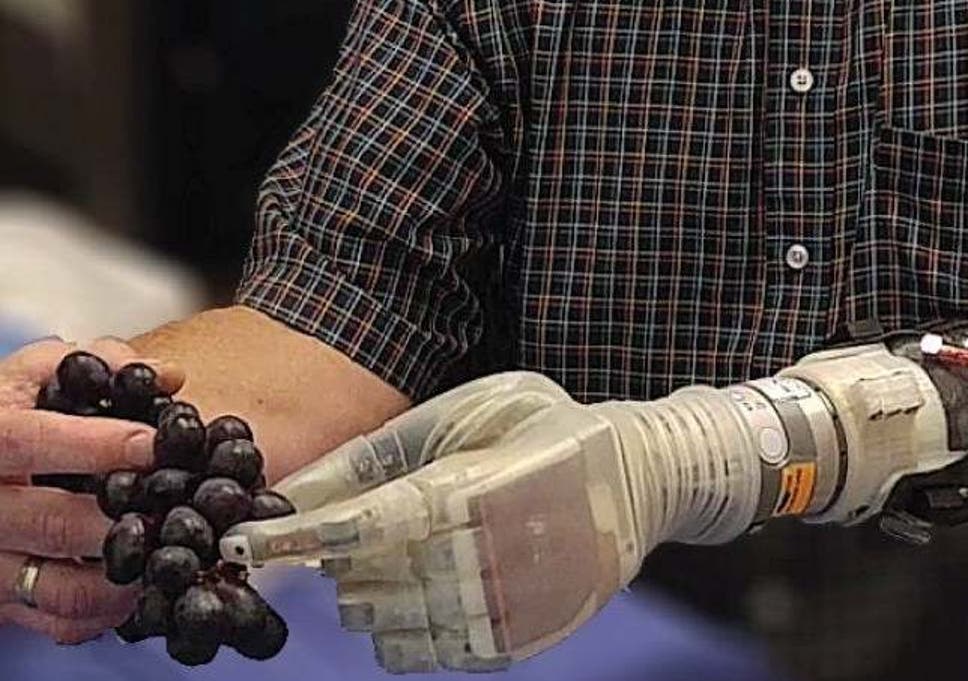The Intelligence of Bionic Prosthetics
"Touch isn't a single sense. When you first touch objects with a natural hand, there's an extra burst of neural impulses."
"When the prosthetic hand starts to feel like the user's real hand, the brain is tricked into thinking that it actually is real. Hence, the phantom limb doesn't have a place to live in the brain anymore. So it goes away -- and with it goes the phantom pain."
"Participants can feel over 100 different locations and types of sensation coming from their missing hand. They can also feel the location and the contraction force of their muscles -- even when muscles aren't there. That's because we can send electrical signals up the sensory fibres from the muscles, so the brain interprets them as real."
Gregory Clark, associate professor of biomedical engineering, University of Utah
 |
| University of Utah biomedical engineering doctoral student Jacob George, left, and associate professor Gregory Clark, are helping develop a prosthetic arm that can move via the wearer's thoughts as well as feel the sensation of touch to make it easier to pick up and hold objects. Dan Hixson/University of Utah College of Engineering |
"We are moving toward an autonomous system that will learn to perform new actions as per the user's intentions with the least supervision from outside, and enable the user to control the prosthetic more independently."
Taruna Yadav, PhD student
"Our main goal is to let patients control the prosthetic as though they were their biological limbs."
"This new technology takes us a step closer to achieving this."
"In both cases [bionic body part for amputee or paralyzed person], it will still read the user's neural activity and generate a command to control a prosthetic limb."
"However, the time and effort required to learn to control the BCI [brain-computer interface] output may differ."
Dario Farina, lead author, 2018 paper
 |
| Photo credit: University of Utah Center for Neural Interfaces |
Prosthetics designed to closely mimic part of the human body they are meant to replace are the focus of researchers around the world. Ambition sees new prosthetics transcending mere cosmetic, let alone functional purposes. The new prosthetics are bionic body parts able to touch and feel, and beyond, including learning new things. Characteristics such as firmness, texture and temperature, crucial in determining how interaction will take place with an object sees the brain "translate" these functions and feelings.
Someone using one of the new prosthetics, an arm, for example, is able to "feel" the delicate substance of an egg, in the very same manner as would occur with a natural limb, including using the prosthetic to gently lift the egg and transfer it without harm. One participant in the testing of a new prosthetic "feeling" limb, was able to hold his wife's hand, send a text message, and pluck grapes from a bunch, despite having lost his natural arm a decade before. The phantom pain he suffered despite the absence of his natural arm had subsided.
Professor Clark's research team achieved such results through stimulating the sensory nerve fibres in a "biologically realistic" manner with the use of a computer algorithm. Through this process they were enabled to provide a more biologically realistic digital pulse with a verisimilitude to what the brain itself normally receives in neural impulses from a natural arm. Communication between the brain and a robotic body part -- the brain-computer interface -- is the critical component of a thought-powered prosthetic.
In some mind-controlled prosthetics, brain implants are used to send instructions to a robotic limb similar to the way neurons transmit messages from brain to muscle. This method comes with the risks, cost and recovery time of precision brain surgery, however, quite beyond the brain-computer interface using a neural interface. A breakthrough was announced in June of a "mind-controlled robotic arm ... that demonstrated for the first time to our knowledge, the capability for humans to continuously control a robotic device using non-invasive EEG signals" according to Bin He, professor, head of biomedical engineering at Carnegie Mellon University.
Non-invasive BCIs have demonstrated promising results in performing distinct actions; pushing a button for example. BCI use had resulted in disjointed movements of the robotic prosthesis in continuous, sustained action like tacking a cursor on a computer screen; but now the prosthetic finger followed the cursor in a smooth, continuous path, emulating a real finger with the use of a computer-wired EEG cap on the subject in the lab.
A new smartphone app programmed with EEG recordings and wireless electrodes, according to Professor He, could streamline the process for everyday use, paving the way for thought-controlled robotic devices by decoding "intention signals" from the brain, absent invasive and risky brain surgery. Prosthetics must be calibrated for specific use and to that end engineers at the lab of Joseph Francis, associate professor of biomedical engineering at University of Houston have been applying themselves to a BCI to autonomously update using implicit user feedback.
A bionic hand developed through collaboration between the Imperial College London and University of Gottingen in 2018 used a human-machine interface interpreting the wearer's intentions to send commands to the artificial limb. Machine learning-based techniques to interpret neural signals from the brain to improve the performance of prosthetic hands were used by the team.
 |
| Keven Walgamott tests a robotic arm which can give amputees the sensation of touch through sensors in the hand, making it easier to pick up and hold objects ( University of Utah/SWNS ) |
Labels: Amputtees, Artificial Limbs, Computers, Neural Communication, Research, Robotic Limbs

0 Comments:
Post a Comment
<< Home